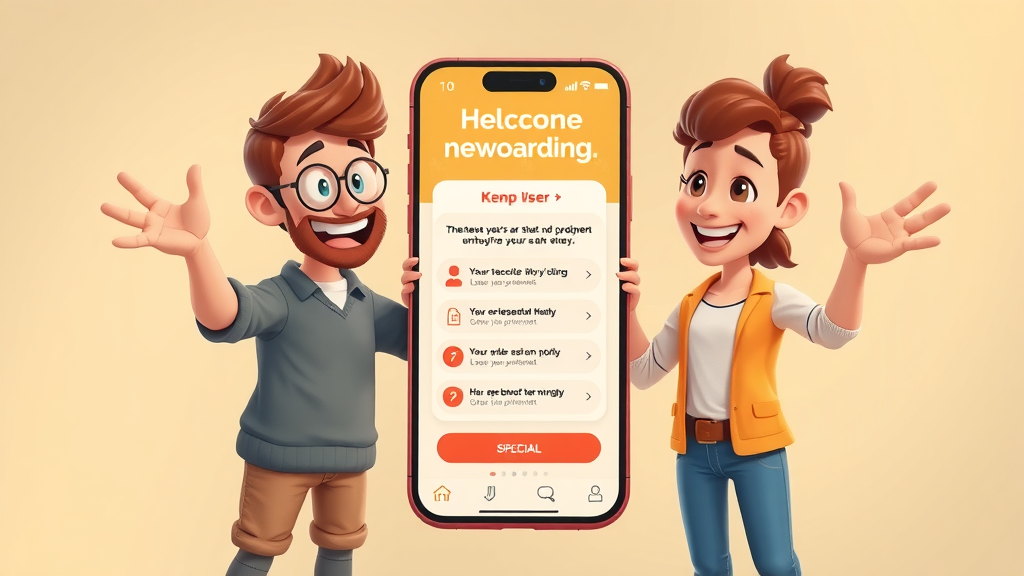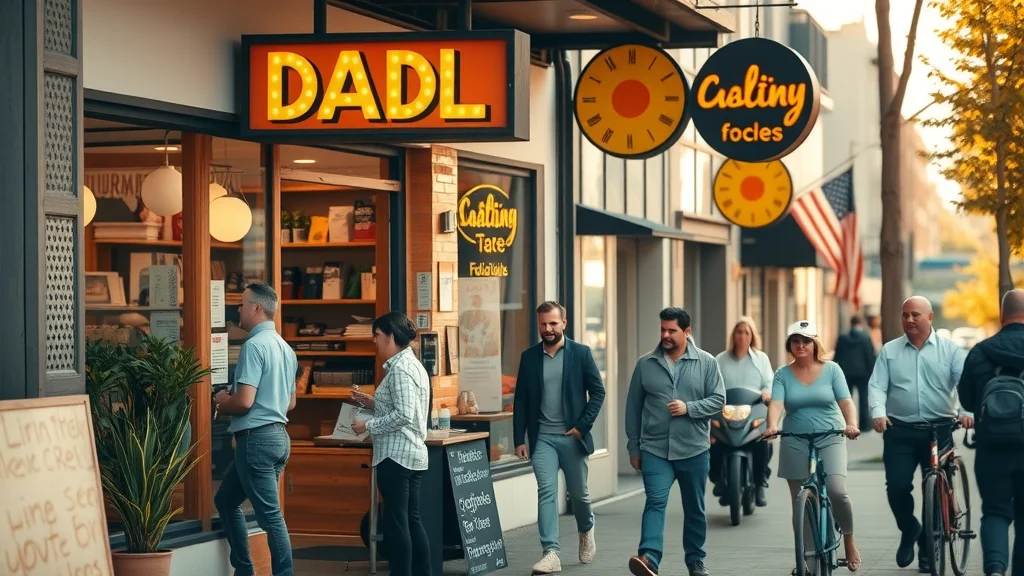Did you know that 70% of app users abandon an app within just 90 days? This eye-opening statistic reveals a massive opportunity hiding in plain sight: improving customer engagement with apps can singlehandedly determine whether your mobile app thrives or fades away. In today’s saturated mobile marketplace, true app success is more than just downloads – it’s about keeping users engaged, loyal, and active. If you're looking for proven methods to amplify mobile app engagement, boost user retention, and maximize your business outcomes, this comprehensive guide has you covered from start to finish.
A Surprising Truth: How Improving Customer Engagement with Apps Delivers Measurable Business Growth
- The key drivers behind improving customer engagement with apps
- Actionable engagement strategies to enhance user retention and loyalty
- How mobile app engagement impacts revenue and business outcomes
- Best practices for building a customer-focused app experience

When it comes to improving customer engagement with apps , many brands underestimate just how much impact a truly engaged user base can make. A well-engaged app user doesn't just spend more time in your mobile app; they’re more likely to become loyal customers, participate in loyalty programs, and contribute substantially to your bottom line. The surge in mobile app engagement translates directly into increased usage, in-app purchases, glowing reviews, and referrals on social media. The benefits for app owners are tangible: higher user retention , improved app ratings, and a competitive edge in crowded app stores.
In this article, you’ll gain practical insights on proven app engagement strategies , learn how to track the metrics that matter most, and discover real-world examples that can inspire your own mobile app journey. With the increasing dependency on mobile apps for everyday tasks, understanding how to engage your users is the fastest path to sustained business growth and customer loyalty.
Why Improving Customer Engagement with Apps Is a Game-Changer for Mobile App Growth
The race to capture and keep users on mobile apps is fierce. With millions of mobile app downloads but even more app abandonment, user engagement has become the single most important factor determining an app's longevity and profitability. When improving customer engagement with apps , you not only reduce churn but also lay the foundation for long-term success and scalable revenue growth.
Strong customer engagement leads to a higher number of active users , positive reviews, and increased word-of-mouth on social media. Apps with robust engagement benefit from greater visibility in app stores, rise above competitors in crowded marketplaces, and frequently secure a spot in the coveted “top charts.” Most notably, users engaged with a mobile app return more frequently, interact longer per session, and are more likely to invite friends—multiplying your organic reach.
Exploring the Relationship Between User Engagement and Mobile App Success
At the core of every successful mobile app is a well-thought-out engagement strategy that prioritizes the needs and preferences of the app user . App engagement isn’t a vanity metric; it’s a quantifiable measure of how invested your app users are. The longer you keep active users returning and the more delight you deliver across the app experience , the greater your app’s staying power in a competitive landscape.
Key elements like interactive onboarding, targeted push notifications, and frequent updates all combine to create a user experience that keeps engaged users coming back daily. Studies have demonstrated that mobile apps focusing on app engagement see a dramatic lift in both daily and monthly active user counts. Captivating in-app experiences and meaningful user journeys are the strategic assets of mobile app winners.
The Economic Benefits of Strong App Engagement
High mobile app engagement is directly linked to revenue gains and stronger business performance. Loyal, active users are statistically more likely to make in-app purchases and participate in loyalty programs , driving up average revenue per user. Retaining existing users is significantly more cost-effective than acquiring new ones, meaning robust engagement strategies deliver impressive ROI.
Brands investing in personalized engagement and feedback mechanisms see stronger customer satisfaction scores, improved ratings, and more organic downloads via word-of-mouth. Every additional percent gained in user retention can compound into thousands of dollars in future returns. Exceptional app experience is no longer optional—it’s a critical driver of competitive advantage for any business with a presence on mobile apps .
“70% of app users abandon an app within 90 days. Prioritizing customer engagement can build a loyal, active user base.”
Core Principles of Mobile App Engagement and Improving Customer Engagement with Apps

To master the art of improving customer engagement with apps , you must understand the core principles that underpin a memorable and meaningful app experience . Top-performing apps approach every user interaction as an opportunity—using personalization, seamless navigation, and proactive app messages to drive connections that last. The entire user journey , from onboarding to loyal advocacy, is crafted to keep users engaged at each step.
It’s crucial to focus on three pillars: meeting user needs, delivering value quickly, and building feedback loops into your mobile app workflows. Embedding these principles not only increases the number of active users but also boosts user retention over months and years. As user expectations shift, continuous improvements and regular feature updates become the heartbeat of sustained app success.
Mastering App Engagement: How to Keep Users Engaged Throughout the User Journey
A successful mobile app engagement strategy requires gripping users from their very first tap. The initial onboarding process must clarify the app’s core value quickly while guiding new app users through essential features. As users progress, targeted nudges—such as push notifications and contextual rewards—maintain excitement and involvement, transforming occasional users into daily participants.
Keep engaging your app users by introducing new content, interactive challenges, and social features. Consistent updates, gamification, and real-time in-app messaging help nurture an ever-deepening connection between the user and your app. When the user journey feels dynamic and personally rewarding, the chances of long-term engagement soar.
Navigating User Experience: Essential Elements of a Customer-Centric Mobile App
A truly customer-centric mobile app is built on intuitiveness, seamless interface design, and immediate value delivery. Users should be able to accomplish key tasks with minimal friction. Personalization—whether through recommendations or dynamic content—ensures each app user feels uniquely recognized and valued. Accessibility features and fast loading times further enhance the user experience , making lag or confusion a thing of the past.
Regularly collect feedback to learn what resonates with users engaged in your app journey. This continual adaptation ensures you’re always aligned with evolving expectations, strengthening both user engagement and app loyalty. By putting the customer’s goals first, you cement both satisfaction and retention.
| App Name | DAUs | MAUs | Retention Rate | Avg. Session Length |
|---|---|---|---|---|
| App A | 1M | 10M | 32% | 6 min |
| App B | 600K | 8M | 25% | 4.2 min |
| App C | 400K | 7M | 29% | 5 min |
App Engagement Strategies: Proven Methods for Improving Customer Engagement with Apps
Enriching mobile app engagement takes more than inspirational design; it demands a mix of smart engagement strategies tailored to your audience. Today’s top apps deploy an evolving playbook of push notifications, personalized content, gamified rewards, and timely app updates to keep the mobile experience fresh, engaging, and hard to put down.
Below, we’ll explore tested tactics that help cultivate engaged users , spark ongoing interaction, and ensure users feel invested in every stage of your mobile app .
Push Notifications: Powerful Tools to Boost App Engagement

Push notifications are among the most effective tools for sustaining high levels of app engagement . When used thoughtfully, a timely push notification re-engages users who haven’t visited your mobile app in a while, invites active users to explore new features, or prompts completion of personalized tasks. Personalized messaging—based on user behavior and preferences—often outperforms generic blasts, resulting in higher open rates and conversions.
However, balance is crucial; overly frequent or irrelevant notifications risk irritating engaged users and driving app uninstalls. As part of your engagement strategy , segment your audience, test optimal frequencies, and continually refine your messaging to maximize benefit while minimizing disruption.
Personalization: Elevating the App Experience for Every App User
Personalization turns a standard app into an indispensable daily tool. By adapting content, features, and rewards based on each app user’s preferences and behavior, you create a more relevant and rewarding experience. Top apps analyze valuable insights —like usage patterns, favorite features, and frequently accessed content—to serve up recommendations, tailored push notifications, and context-sensitive offers.
This extra attention to personalization increases time spent in the app, boosts user retention , and drives higher satisfaction. As technology evolves, leveraging machine learning for even more customized experiences will set your mobile app apart from the competition.
Gamification and Loyalty Programs: Turning Users into Engaged App Customers
Gamification and well-structured loyalty programs transform mundane experiences into enjoyable challenges that keep users engaged and eager to return. Features like streaks, points, badges, and rewards cater to our innate desire for achievement and recognition. These tactics not only appeal to competitive spirits but also encourage repeated visits and higher engagement with new features or content updates.
By attaching tangible value to continued usage—such as exclusive perks or unlockable content—apps can drastically increase active user percentages and decrease churn rates. The most successful loyalty programs are those that continually evolve based on feedback, ensuring they always feel fresh and motivating.
- Key Engagement Strategies:
- Dynamic onboarding process
- Targeted push notifications
- Custom rewards in loyalty programs
- Contextual in-app messaging
- Regular feature and content updates
User Retention Tactics: Sustaining Active User Engagement with Mobile Apps

User retention is the lifeblood of successful mobile apps . Once a user signs up, the challenge is to sustain their interest and keep them coming back repeatedly. Effective user retention relies on delivering ongoing value through new features, consistent engagement, and a communications strategy that makes every user feel heard and appreciated. Highly engaged users are far more likely to stick around, becoming advocates for your brand and contributing to sustained app growth.
App creators who focus on a seamless onboarding process , personalized interactions, and responsive support systems often see dramatic improvements in active user retention rates. The secret to exceptional retention is understanding what your users value most and delivering it better than anyone else.
Onboarding Excellence: Setting the Stage for Long-Term Customer Engagement

The onboarding process is your first chance to make a lasting impression. A smooth, intuitive onboarding experience educates new users about key features and highlights the unique value proposition of your mobile app . Incorporate welcome tutorials, tooltips, and showcase your app’s best assets early on to help users achieve their goals faster.
Successful onboarding also minimizes user frustration by removing unnecessary hurdles. Allow users to skip steps and return later, or offer quick demos rather than lengthy manuals. Engaged users appreciate guided setup, instant wins, and a sense that their needs are anticipated right from the start.
Leveraging App Feedback Loops and Customer Service for Better Engagement
Listening to your users is critical. Embedding feedback options and easy-to-reach customer service within your mobile app ensures users have a direct channel for voicing concerns, sharing suggestions, or requesting support. This strengthens the relationship between app owner and app user , demonstrating that every opinion matters.
Through periodic surveys, in-app polls, or proactive customer outreach, you gain the valuable insights needed to refine the app experience and rapidly resolve pain points. In turn, users feel empowered, boosting retention and forming the foundation of long-term engagement.
“Continuous improvement starts with listening to your app users.”
Data-Driven Insights: Measuring and Optimizing Your Mobile App Engagement Strategy
To truly excel at improving customer engagement with apps , app owners must track, analyze, and react to key engagement metrics. These benchmarks—like daily active users , retention rate , session frequency , and churn rate —reveal exactly how users interact with your mobile app and which areas need refinement. Monitor these regularly to spot trends before they become problems and stay aligned with evolving user expectations.
Data collected from analytics dashboards uncovers which features delight users, when and why churn occurs, and how best to allocate resources for updates or marketing campaigns. By acting on this intelligence, you ensure your app engagement strategy grows stronger over time, aligned with what active users value most.
| Metric | Description |
|---|---|
| Daily Active Users | Number of unique users per day |
| Monthly Active Users | Number of unique users per month |
| Retention Rate | Users returning after initial engagement |
| Session Frequency | Average app opens per user |
| Churn Rate | Users who stopped engaging |
Designing Rewarding App Experiences to Improve Customer Engagement with Apps
Delightful mobile app experiences turn casual visitors into passionate, engaged users . Loyalty programs, user segmentation, and the regular integration of feedback keep the experience feeling fresh and personalized. A rewarding app journey isn’t static; it’s continuously evolving to meet users’ ever-changing needs.
When every interaction feels valued—whether through rewards, recognition, or new challenges—users are more likely to recommend your mobile app to friends, boosting organic growth and market position.
Building Loyalty Programs for Continued Mobile App Engagement
Loyalty programs harness the power of incentive to boost long-term user retention . Offer points, badges, or exclusive deals to active users attending daily sessions or achieving certain in-app milestones. The most effective loyalty models tailor rewards to specific user segments, creating a sense of exclusivity and heightened motivation.
Combined with gamified challenges and regular progress updates, loyalty programs help increase engagement rates and ensure your app is central to users’ daily routines. Make it easy for users to track their progress and unlock new perks as they deepen their relationship with your app.
Segmenting App Users for Tailored Customer Engagement

User segmentation is a powerful tool to increase the efficiency of all your engagement strategies . By grouping app users based on demographics, behavior, preferences, and app activity, you can tailor in-app messaging , rewards, and support to resonate deeply with each group.
This highly targeted approach ensures every app user receives relevant communications and feels valued. Segmentation also helps prioritize product development efforts, as you uncover which features or rewards have the greatest impact for specific user types, driving measurable improvements in mobile app engagement .
Integrating Customer Experience Feedback to Refine App Engagement Strategy
Continuously seeking and incorporating user feedback is crucial for optimizing your app engagement strategy . Proactive requests for reviews, surveys, or feature suggestions provide the insights needed to improve the app experience for every engaged user . Build visible channels—such as in-app help centers and feedback buttons—so users can share thoughts the moment inspiration strikes.
Iterating quickly based on actual user input keeps your app responsive, relevant, and beloved by its audience. The most successful apps make their community feel heard and respected, transforming loyal users into true brand advocates.
- App Engagement Strategies Checklist:
- Set measurable goals for engagement
- Use A/B testing for feature optimization
- Personalize content and rewards
- Encourage social sharing and referrals
- Monitor user behavior analytics
How to Increase User Engagement in Apps: Actionable Steps
If you’re ready to boost user engagement in your mobile apps , embrace the following actionable steps to transform your customer experience and achieve outstanding results.
Customize Push Notifications for Timely User Engagement
Timing and relevance are everything. Use in-depth user behavior data to determine the optimal moments for sending push notifications . These nudges can remind users of incomplete tasks, notify them about special offers, or highlight new content related to their interests. Personalization, such as using the user’s name or referencing recent actions, can substantially improve open rates and overall app engagement .
Remember, excessive notifications can be counterproductive. Continually monitor analytics and user feedback to fine-tune the frequency and content of your push messages, ensuring they’re always welcomed rather than ignored.
Optimize the Onboarding Process for an Engaged User Base
A streamlined onboarding process removes roadblocks for newcomers and sets clear expectations from the start. Interactive tutorials, welcome incentives, and real-time support can accelerate a new app user’s journey to engaged usage. Encourage early exploration by highlighting “aha!” moments and personalizing onboarding content based on individual demographics or goals.
Keep onboarding concise yet informative, avoiding information overload, and give new users concrete reasons to return after their initial session—through introductory rewards, follow-up emails, or welcome notifications.
Regularly Update Mobile Apps with New Features to Maintain App Engagement

Stagnant apps quickly lose their allure. Roll out new features, content updates, or gamified events on a consistent schedule to keep your engaged users excited and invested in your mobile app . Announce major updates with in-app messages or notifications, encouraging both new and long-time users to explore what’s fresh.
Engagement often spikes following new releases, so use these opportunities to solicit feedback and spotlight your commitment to ongoing improvement.
- Analyze valuable insights from user behavior
- Implement real-time support and customer service
- Foster community via in-app forums and chat
- Deploy cross-channel engagement strategies
- Reward users for milestones achieved
Why Do Apps Have Better Customer Engagement? The Secrets Behind Mobile Apps Success
Apps outperform other digital channels in customer engagement thanks to their immediacy, interactivity, and the seamless experiences they provide. The ability to customize content, respond to real-time feedback, and incorporate dynamic features gives mobile apps a clear edge over traditional websites or email platforms.
Instant Interactions and Seamless User Experience

The convenience of mobile means users can engage on their own terms—whether it’s checking in on the go, responding to notifications, or accessing services with a single tap. Fast loading, intuitive navigation, and attractive design make every visit satisfying for the app user .
Strong app engagement is often a result of apps anticipating user needs, removing friction, and enabling instant action. Minimal waiting and consistent performance set mobile apps apart, providing the quick rewards today’s users crave.
Rich Personalization and Real-Time Engagement Strategies
Mobile apps excel at deploying real-time, data-driven personalization. By considering a user’s past activity, preferences, and even location, apps serve up the most relevant content or offers at the perfect moment. Real-time app messaging —such as context-sensitive push notifications or in-app prompts—keeps engagement high and users feeling valued.
This level of dynamic interactivity drives user satisfaction and loyalty over the long haul, making apps indispensable parts of daily life.
In-Depth Customer Experience and Feedback Loops
Apps uniquely position brands to gather and act on constant feedback, closing the gap between user request and product improvement. Integrated support, simple review options, and targeted surveys create an ongoing dialogue that boosts both user satisfaction and product quality.
This collaborative improvement cycle ensures your mobile app engagement strategy remains responsive and continually refined based on what users care about most.
How Can I Improve My Customer Service App for Better Engagement?
For apps centered on customer service , rapid, responsive assistance is non-negotiable. Successful customer service apps empower users to connect instantly with support teams, resolve issues efficiently, and provide ongoing input that shapes the future of the platform. Below are proven enhancements to deliver outstanding engagement and support outcomes.
Integrate In-App Support: Live Chat & FAQ for App Users
Give app users immediate help inside your mobile app by embedding live chat and robust FAQ sections. In-app chat lets users get real-time answers without leaving your platform, improving satisfaction and reducing drop-off rates. Comprehensive FAQs ensure users can resolve simple issues independently.
This hands-on support builds trust and makes every active user feel valued—key drivers of retention and positive reviews.
Utilize Automated Responses and AI for Faster Customer Service

AI-driven chatbots and automated responses help scale customer support without sacrificing quality. Smart algorithms can resolve common issues, triage requests, and offer instant guidance, dramatically reducing wait times. This not only increases user satisfaction but also allows your human agents to focus on complex queries that need a personal touch.
By combining automation with live support, you provide efficient, around-the-clock assistance—crucial for global mobile apps with users in every time zone.
Monitor User Engagement and Enhance Experience Based on Feedback
Track customer queries, identify trending issues, and regularly analyze feedback to refine your app’s interface and support workflows. User input is golden—it reveals broken processes, missed opportunities, and new feature requests that keep your customer service app aligned with evolving expectations.
Show your users that their suggestions drive real change, and you’ll win their loyalty for the long term.
- Essential Tools for Enhancing Customer Engagement:
- In-app messaging platforms
- AI-powered helpdesk
- User analytics dashboards
- Loyalty and rewards APIs
- Multichannel support integrations
What Is App Engagement? Exploring the Fundamentals
App engagement is the measure of how actively users are involved with your mobile app over time. It goes beyond downloads—tracking actions like session frequency, feature usage, and social sharing. High engagement is strongly linked to long-term customer engagement , higher revenue, and improved customer satisfaction.
Defining App Engagement and Its Importance for Customer Engagement
At its core, app engagement is about keeping active users enthusiastic, involved, and coming back. Engaged users interact regularly, leverage a wide range of app functions, and frequently provide feedback. These behaviors drive better data, more tailored in-app experiences, and the ongoing improvement that’s vital for user retention .
Strong customer engagement emerges naturally from apps that value each interaction and reward repeated participation.
The Link Between Active Users and Customer Lifetime Value
Every improvement in app engagement has a compounding effect on customer lifetime value (CLV). Engaged users are more likely to make purchases, upgrade subscriptions, and refer friends, increasing lifetime revenue per user. By focusing on cultivating active users rather than simply driving downloads, your app builds a sustainable foundation for long-term growth.
Successful apps measure CLV alongside monthly active user totals and churn rates to validate and adjust their mobile app engagement investments.
Case Studies: Successful App Engagement Strategies in Leading Mobile Apps
Leading apps like fitness platforms and mobile banking services rely on habit-forming engagement methods, frequent value delivery, and rapid iteration in response to feedback. In one example, a popular language app increased user retention by 20% after introducing streak rewards and weekly challenges, while another shopping app saw a 30% reduction in churn after implementing personalized push notifications and instant support chat.
Across all cases, the winning formula is the same: listen to users, provide continuous enhancements, and prioritize a feedback-driven development cycle.
- Key Takeaways:
- App engagement drives business growth
- Personalization and usability are essential
- App feedback and analytics are critical
- Continuous optimization magnifies user retention
Frequently Asked Questions on Improving Customer Engagement with Apps
- What are the best user engagement metrics to track? Track daily active users (DAUs), monthly active users (MAUs), retention rate, churn rate, and average session length. These metrics reveal how much value users receive from your app and where to focus improvements.
- How often should push notifications be sent? Push notifications should be personalized and sent based on user behavior—generally 1-3 times per week for most apps. Excessive notifications risk user fatigue and potential uninstalls.
- What are the most effective loyalty program features in mobile apps? Offer points, exclusive rewards, progress badges, and milestone-based challenges. Tie rewards to meaningful actions and personalize them for the best engagement outcomes.
- Can user engagement improve app ratings and reviews? Absolutely—engaged users who get value from the app are more likely to leave positive reviews and higher ratings, improving discoverability in app stores.
- How does user feedback influence app growth? User feedback helps identify bugs, inspire new features, and validate development priorities. Apps that act on feedback build loyalty and see ongoing growth.
Drive Results: Transform Customer Engagement with Mobile Apps Now
“The apps that win user loyalty focus relentlessly on customer engagement, experience, and ongoing value.”
- Re-examine your engagement strategies
- Leverage analytics to tailor app experiences
- Actively solicit and implement user feedback
- Build a community of engaged users
- Contact our marketing experts for a personalized strategy
Ready to Start Improving Customer Engagement with Apps and Achieve Mobile App Success?
- Need Clients Seeing Your Business FIRST? Build Your Online Presence & Grow Your Business Affordably... Be Seen As The 5 Star Rated Local Expert Above Competition Today! Call or Text (352) 266-0499 or Email John@LocalMarketingResource.com
Start implementing these proven strategies today, track your results, and be ready to adapt. The path to mobile app success starts with improving customer engagement at every touchpoint.
To further enhance your understanding of improving customer engagement with apps, consider exploring the following resources:
-
“22 Proven Strategies to Improve App Engagement in 2025” ( vwo.com )
-
“How Mobile Apps Are Revolutionizing Customer Engagement” ( outcodesoftware.com )
These articles provide actionable strategies and insights to help you boost user retention and loyalty through effective app engagement techniques.
 Add Row
Add Row  Add
Add 




Write A Comment